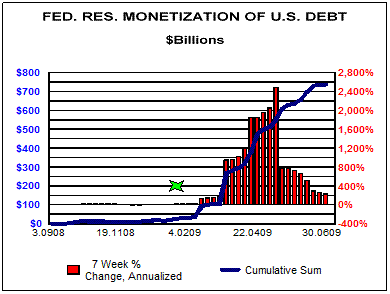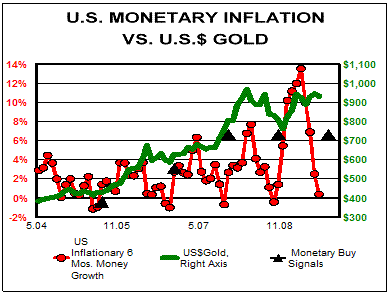Fed Monetization of U.S. Debt to Drive Gold Higher
Commodities / Gold & Silver 2009 Jul 06, 2009 - 02:11 PM GMTBy: Ned_W_Schmidt
 Global condemnation of the Obama Regime’s failing economic policies continues to grow. India is now questioning their investment in U.S. dollar denominated assets. That nation is the latest to join China, Russia, and Brazil in publicly worrying over the consequences of those misguided policies. BRIC has now become the most prominent activist investor group trying to either create an alternative to the U.S. dollar or force sound financial policies on the U.S.
Global condemnation of the Obama Regime’s failing economic policies continues to grow. India is now questioning their investment in U.S. dollar denominated assets. That nation is the latest to join China, Russia, and Brazil in publicly worrying over the consequences of those misguided policies. BRIC has now become the most prominent activist investor group trying to either create an alternative to the U.S. dollar or force sound financial policies on the U.S.
Quite simply, they are wasting their breath and their time. First, the Obama Regime has no interest in sound economic policies. When one is busy buying votes, one does not worry about the balance sheet. Second, the idea of creating a paper alternative, such as through the IMF, is DOA. The IMF has neither the mandate nor the global support for creating a fiat reserve currency. Besides, the world already has an alternative to the U.S. dollar. We call it Gold!
 Our first chart above is a variation on one considered two weeks ago. The blue line, using the left axis, is the cumulative monetization by the Federal Reserve of U.S. government debt for the period of time covered by the graph. Monetization is simply the purchase of U.S. government debt by Federal Reserve. In simplistic terms, it is using the “printing press” to finance the U.S. government.
Our first chart above is a variation on one considered two weeks ago. The blue line, using the left axis, is the cumulative monetization by the Federal Reserve of U.S. government debt for the period of time covered by the graph. Monetization is simply the purchase of U.S. government debt by Federal Reserve. In simplistic terms, it is using the “printing press” to finance the U.S. government.
Rather than buying the debt directly from the government, the Federal Reserve uses a subterfuge. U.S. government sells new debt to what are referred to as primary bond dealers, who then market it to gullible buyers. Federal Reserve then buys bonds from banks and primary dealers. In this way it does not look like Federal Reserve trucks are delivering money directly to the Treasury, but the net effect is the same. This methodology has been highly popular by “banana republics” around the world over time. See Zimbabwe for consequences of this process.
Red bars, using right axis, represent the 7-week rate of change, annualized, of the monetization of U.S. debt by the Federal Reserve. The extremely high rate to which debt monetization rose indicates either panic or complete capitulation to the political machine now running Washington. Never in peace time has the Federal Reserve so abdicated its independence.
Economic implications of this debt monetization are not hard to discover. A massive increase in dollar liquidity pushed financial markets up strongly. Those free flowing dollars set the stage for the second quarter stock market rally. The Gold market also benefitted from that action, pushing the dollar price of Gold higher. Additionally, naive bottom fishers also bought homes with mortgages made cheaper by this debt monetization.
In recent weeks, the Federal Reserve has lifted its food off the gas, or dollar liquidity, pedal. The rate at which dollars flowed into the markets has slumped. The second derivative is the influence in which we are most interested as it is what drives investment markets. The second derivative turned negative.
As a consequence, financial markets have faltered. The U.S. dollar has stabilized somewhat due to supply of dollars growing slower. Gold’s rally has turned into a consolidation.
On the ground that burst of liquidity was also felt. Mortgage activity and housing sales picked up in the U.S. That caused some belief that the U.S. economy might be bottoming. While the Obama Regime’s policies are anti growth, a massive liquidity injection can slow the rate of descent. Now though, with the liquidity spigot being turned down, the U.S. economy will move toward a double dip recession. Another leg down for the U.S. economy will develop due to this slowing of liquidity injection and the budget problems of so many states, California and Illinois for example.
 The red line of circles in our second chart is the rate of change in the U.S. money supply, using the left axis. That lower rate of liquidity growth is already translating into slower money supply growth. $Gold tends to stall out as that happens. However, politics may come to the rescue. Any impression of a slowing in the U.S. economy will cause political pressure on the Federal Reserve. By end of Summer, it will likely be more aggressive in debt monetization. That should turn that money supply measure back up.
The red line of circles in our second chart is the rate of change in the U.S. money supply, using the left axis. That lower rate of liquidity growth is already translating into slower money supply growth. $Gold tends to stall out as that happens. However, politics may come to the rescue. Any impression of a slowing in the U.S. economy will cause political pressure on the Federal Reserve. By end of Summer, it will likely be more aggressive in debt monetization. That should turn that money supply measure back up.
We have used that money measure to create buy signals on $Gold, as marked by black triangles in the graph. Those occur when the measure is negative and then turns positive. Given both seasonal and political factors, we are projecting this indicator to possibly give another buy signal in September. That should set the stage for $Gold to convert $1,000 from a ceiling to a floor!
Investors are being given a rare opportunity this Summer. Weak Gold prices, brought on by Federal Reserve policy, are providing what over time will be seen as buyer’s bargain. Investors should be using these prices to build a portfolio of Gold. Someday, buying Gold below $1,000 will be seen as buying low for some, and a moment of regret for those that do not take action.
By Ned W Schmidt CFA, CEBS
Copyright © 2009 Ned W. Schmidt - All Rights Reserved
GOLD THOUGHTS come from Ned W. Schmidt,CFA,CEBS, publisher of The Value View Gold Report , monthly, and Trading Thoughts , weekly. To receive copies of recent reports, go to http://home.att.net/~nwschmidt/Order_Gold_GETVVGR.html
Ned W Schmidt Archive |
© 2005-2022 http://www.MarketOracle.co.uk - The Market Oracle is a FREE Daily Financial Markets Analysis & Forecasting online publication.



